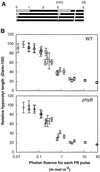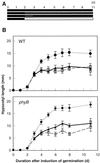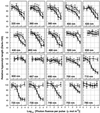Elementary processes of photoperception by phytochrome A for high-irradiance response of hypocotyl elongation in Arabidopsis
- PMID: 10631258
- PMCID: PMC58853
- DOI: 10.1104/pp.122.1.147
Elementary processes of photoperception by phytochrome A for high-irradiance response of hypocotyl elongation in Arabidopsis
Abstract
Elementary processes of photoperception by phytochrome A (PhyA) for the high-irradiance response (HIR) of hypocotyl elongation in Arabidopsis were examined using a newly designed irradiator with LED. The effect of continuous irradiation with far-red (FR) light could be replaced by intermittent irradiation with FR light pulses if given at intervals of 3 min or less for 24 h. In this response, the Bunsen-Roscoe law of reciprocity held in each FR light pulse. Therefore, we determined the action spectrum for the response by intermittent irradiation using phyB and phyAphyB double mutants. The resultant action spectrum correlated well with the absorption spectrum of PhyA in far-red-absorbing phytochrome (Pfr). Intermittent irradiation with 550 to 667 nm of light alone had no significant effect on the response. In contrast, intermittent irradiation with red light immediately after each FR light pulse completely reversed the effect of FR light in each cycle. The results indicate that neither red-absorbing phytochrome synthesized in darkness nor photoconverted Pfr are physiologically active, and that a short-lived signal is induced during photoconversion from Pfr to red-absorbing phytochrome. The mode of photoperception by PhyA for HIR is essentially different from that by PhyA for very-low-fluence responses and phytochrome B for low-fluence responses.
Figures





Similar articles
-
Regulation of phytochrome B signaling by phytochrome A and FHY1 in Arabidopsis thaliana.Plant J. 1999 Jun;18(5):499-507. doi: 10.1046/j.1365-313x.1999.00475.x. Plant J. 1999. PMID: 10417700
-
Phytochrome A enhances the promotion of hypocotyl growth caused by reductions in levels of phytochrome B in its far-red-light-absorbing form in light-grown Arabidopsis thaliana.Plant Physiol. 1996 Nov;112(3):965-73. doi: 10.1104/pp.112.3.965. Plant Physiol. 1996. PMID: 8938405 Free PMC article.
-
A rice phytochrome A in Arabidopsis: The Role of the N-terminus under red and far-red light.Mol Plant. 2008 Jan;1(1):84-102. doi: 10.1093/mp/ssm010. Epub 2007 Oct 31. Mol Plant. 2008. PMID: 20031917
-
Shedding (far-red) light on phytochrome mechanisms and responses in land plants.Plant Sci. 2014 Mar;217-218:36-46. doi: 10.1016/j.plantsci.2013.11.013. Epub 2013 Nov 28. Plant Sci. 2014. PMID: 24467894 Review.
-
Two Distinct Molecular Types of Phytochrome A in Plants: Evidence of Existence and Implications for Functioning.Int J Mol Sci. 2023 May 2;24(9):8139. doi: 10.3390/ijms24098139. Int J Mol Sci. 2023. PMID: 37175844 Free PMC article. Review.
Cited by
-
Phytochrome Signaling Is Mediated by PHYTOCHROME INTERACTING FACTOR in the Liverwort Marchantia polymorpha.Plant Cell. 2016 Jun;28(6):1406-21. doi: 10.1105/tpc.15.01063. Epub 2016 Jun 1. Plant Cell. 2016. PMID: 27252292 Free PMC article.
-
In vitro assembly of phytochrome B apoprotein with synthetic analogs of the phytochrome chromophore.Proc Natl Acad Sci U S A. 2001 Mar 13;98(6):3612-7. doi: 10.1073/pnas.051629698. Proc Natl Acad Sci U S A. 2001. PMID: 11248126 Free PMC article.
-
Are NADP-dependent isocitrate dehydrogenases and ferredoxin-dependent glutamate synthase co-regulated by the same photoreceptors?Planta. 2004 Mar;218(5):775-83. doi: 10.1007/s00425-003-1151-z. Epub 2003 Dec 9. Planta. 2004. PMID: 14663586
-
The protein phosphatase 7 regulates phytochrome signaling in Arabidopsis.PLoS One. 2008 Jul 16;3(7):e2699. doi: 10.1371/journal.pone.0002699. PLoS One. 2008. PMID: 18628957 Free PMC article.
-
Rhizome transition to storage organ is under phytochrome control in lotus (Nelumbo nucifera).Planta. 2007 Sep;226(4):909-15. doi: 10.1007/s00425-007-0536-9. Epub 2007 May 23. Planta. 2007. PMID: 17520280
References
-
- Abe H, Takio K, Titani K, Furuya M. Amino-terminal amino acid sequences of pea phytochrome II fragments obtained by limited proteolysis. Plant Cell Physiol. 1989;30:1089–1097.
-
- Ahmad M, Cashmore AR. The blue-light receptor cryptochrome 1 shows functional dependence on phytochrome A or phytochrome B in Arabidopsis thaliana. Plant J. 1997;11:421–427. - PubMed
-
- Bischoff M, Hermann G, Rentsch S, Strehlow D. Ultrashort processes of native phytochrome: femtosecond kinetics of the far-red-absorbing form Pfr. J Phys Chem A. 1998;102:4399–4404.
-
- Blaauw OH, Blaauw-Jansen G, van Leeuwen WJ. An irreversible red-light-induced growth response in Avena. Planta. 1968;82:87–104. - PubMed
Publication types
MeSH terms
Substances
LinkOut - more resources
Full Text Sources
Molecular Biology Databases

